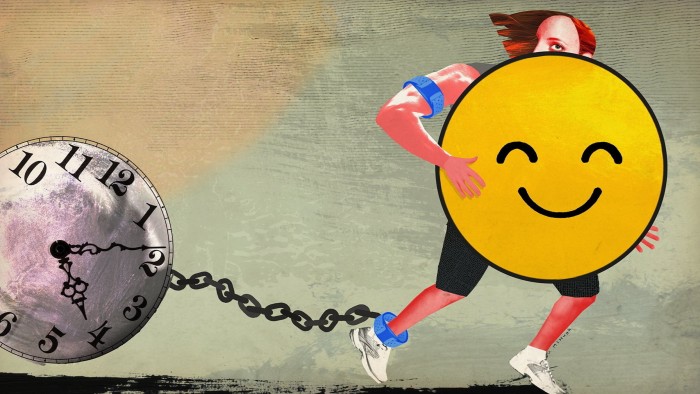Stay informed with free updates
Simply sign up to the Health sector myFT Digest — delivered directly to your inbox.
It used to be quite easy to look successful. You basically just had to brag about how hard you worked. If anyone asked how you were, you’d sigh and say, with just the right smattering of reluctance: “A bit tired actually — I’m crazy busy.” That’s no longer enough. To be truly successful in today’s world you must be properly worn out, from all the extra hours you’re putting into staving off mortality.
Forget boasting about air miles. Yoga, fasting, strength training and blood sugar are becoming essential small talk for every ambitious middle manager. The really rich can show off with ozone therapy, hyperbaric chambers and genetic testing. Much of this is positive. As a status symbol, the quest for longevity is far more beneficial than a Lamborghini. But the pressure to keep up may be having some unfortunate side-effects.
I’m writing this barely able to walk, having ignored a tennis injury a few weeks ago and then compounded it by running. My 10,000 steps have dwindled to about 10. I’d like to cheer myself up with chocolate, but I gave that up to reduce my sugar intake. As a result, I’ve been reading up on “wellbeing burnout”. A survey of more than a dozen countries by the clothing company Lululemon concluded that the “relentless pursuit of wellbeing” could be making people “less well” — partly because they are stressed by all the conflicting advice.
The global “wellness” industry is booming, with larger market share than tourism or IT according to the non-profit Global Wellness Institute (partly because it includes cosmetics). The UK’s wealthy have increased their spending on health and wellbeing by a fifth since the pandemic, according to health insurer Bupa. The challenge is distinguishing the good from the snake oil. Buying “brain training” apps is mostly a waste of money; only a few actually work. Practising extreme fasting, or being injected with “young blood”, carry more serious risks.
I was recently invited on a freebie jaunt to a new wellness spa in Europe that included some experimental treatments, such as bathing in cold plasma. My conversation with the resident “doctor” was not reassuring, and I turned it down. But the prices were astounding. There is clearly a market to get ahead in the longevity race, even if — perhaps especially if — the treatments have not yet been peer-reviewed. This is about getting an edge, and that’s where the problem comes.
Turning health into a competition can be beneficial. There’s loads of evidence that aerobic exercise, for example, is vital for better ageing. But it can backfire. I saw one spinal surgeon who claims to have put two children through private school thanks to patients who have swung kettlebells too enthusiastically. A physio I know reports a boom in clients injured in yoga. A 50-something friend has been felled by not wanting to look weak when a gym trainer half her age insisted on overly heavy weights.
The ultimate symbol of competitive silliness is the “Strava mule” allegedly being paid to boost other people’s scores by running or cycling wearing their smartwatch. Some mules claim to have carried the phones and devices of multiple clients at once. This is a game that only one person wins, and it’s not the person who lied about their score.
The quest to improve health span is fuelling what are in effect a set of unlicensed experiments, by us upon ourselves. With diagnostics now more sophisticated than treatments in some cases, and regulators still reluctant to consider therapies that might treat whole-body ageing, more people are microdosing on magic mushrooms, or buying online products like the peptide NAD or the diabetes drug Metformin. This functions as a sort of parallel test bed — albeit at their own risk.
There is a difference, though, between online supplements or personalised treatment packages delivered to the rich by expensive personal clinicians, and spa treatments whose safety and efficacy is not guaranteed just by featuring on the menu. Whole-body cryotherapy (WBC), which involves subjecting the body to below-freezing temperatures for a few minutes, is now available at all sorts of spas. It has been used in medical settings to treat chronic pain. But dermatologists warn it can cause swelling — and the US Food and Drug Administration says that its “healing benefits are unconfirmed”.
“As more WBC spas open,” says the American Academy of Dermatology Association, “the list of WBC benefits seems to grow.” Meanwhile, experts warn that intravenous “party drips” and shots of vitamins and fat-busting compounds can put the liver and kidneys under stress. They were blamed in 2018 for putting the model Kendall Jenner in hospital. But that hasn’t stopped spas from offering them, or companies in the US and UK delivering them to customers at home.
The high cost of many of these treatments may enhance their boast potential, but price doesn’t always denote quality. Many of the proven routes to reducing the odds of certain diseases, and ageing better, are quite simple and relatively cheap. You could pay a clinic to look for Alzheimer’s biomarkers. Or reduce your alcohol intake, raise your activity levels and eat lots of vegetables and oily fish — which is what the clinic is likely to recommend anyway.
If navigating all these fads has become too stressful, it’s worth focusing on the tried and tested basics: eating less processed food, getting outdoors, exercising consistently and maintaining strong friendships. Those don’t have to be the preserve of the well-off. Beating ourselves up for not having a billionaire body or cheating on our Strava scores may not be a recipe for a better anything.
